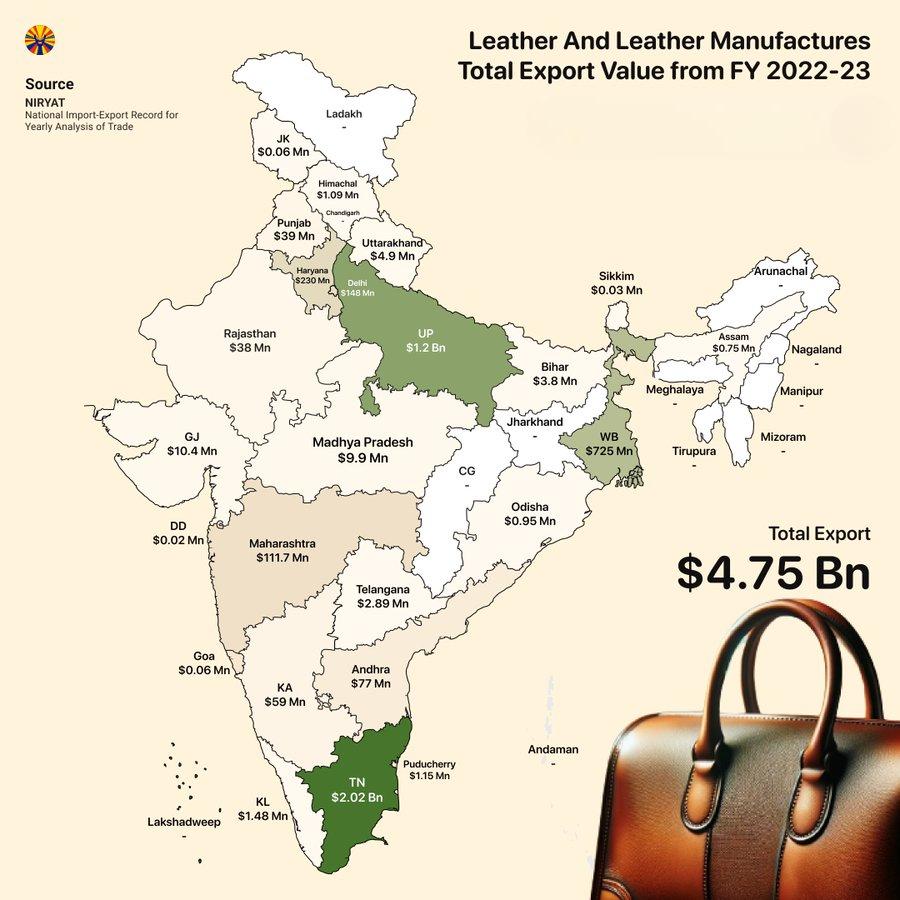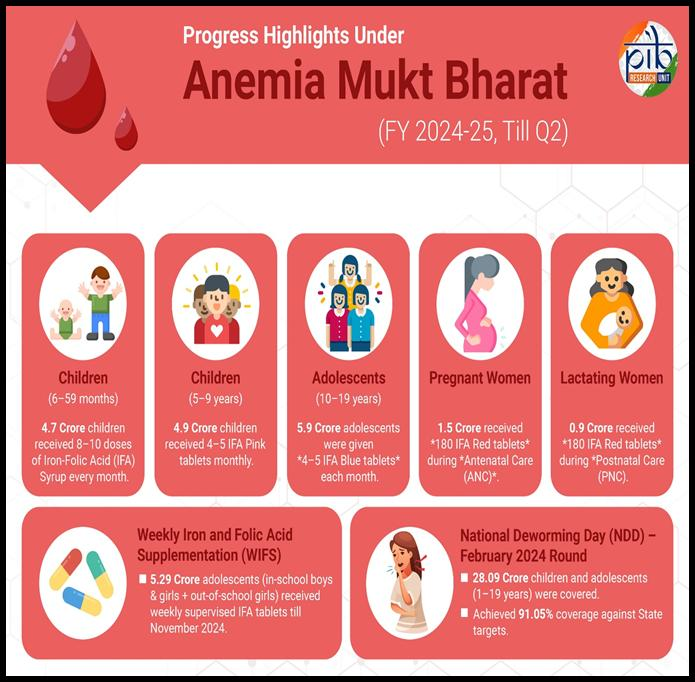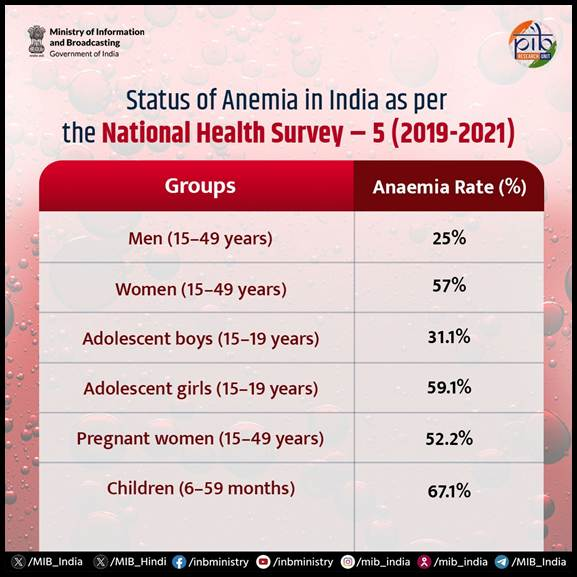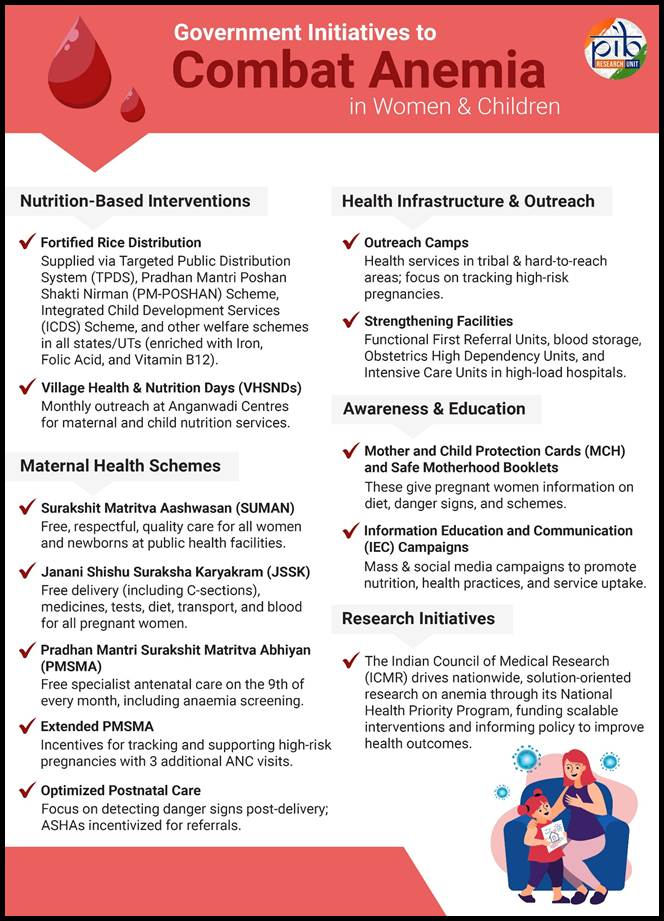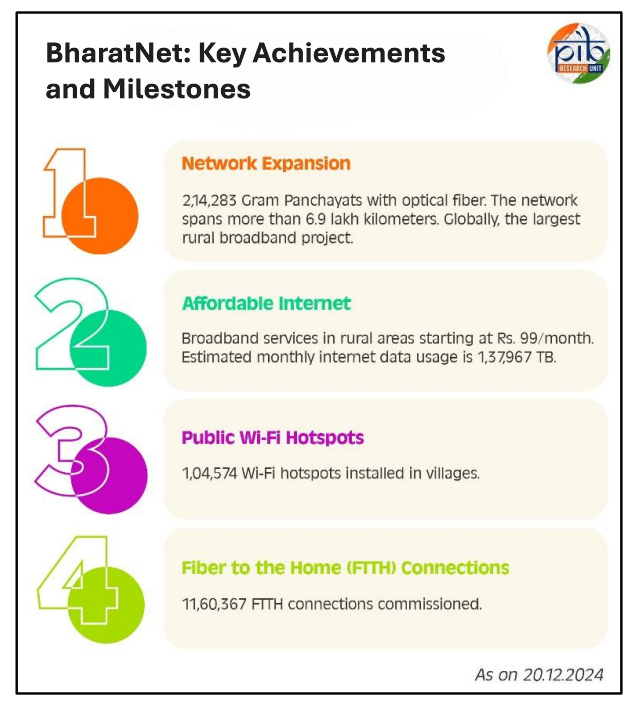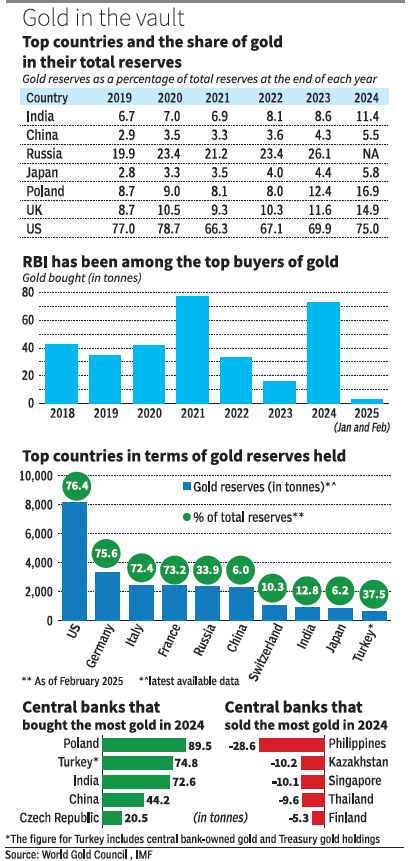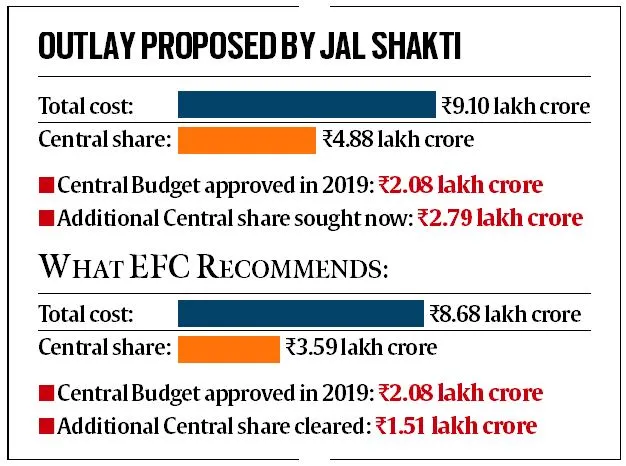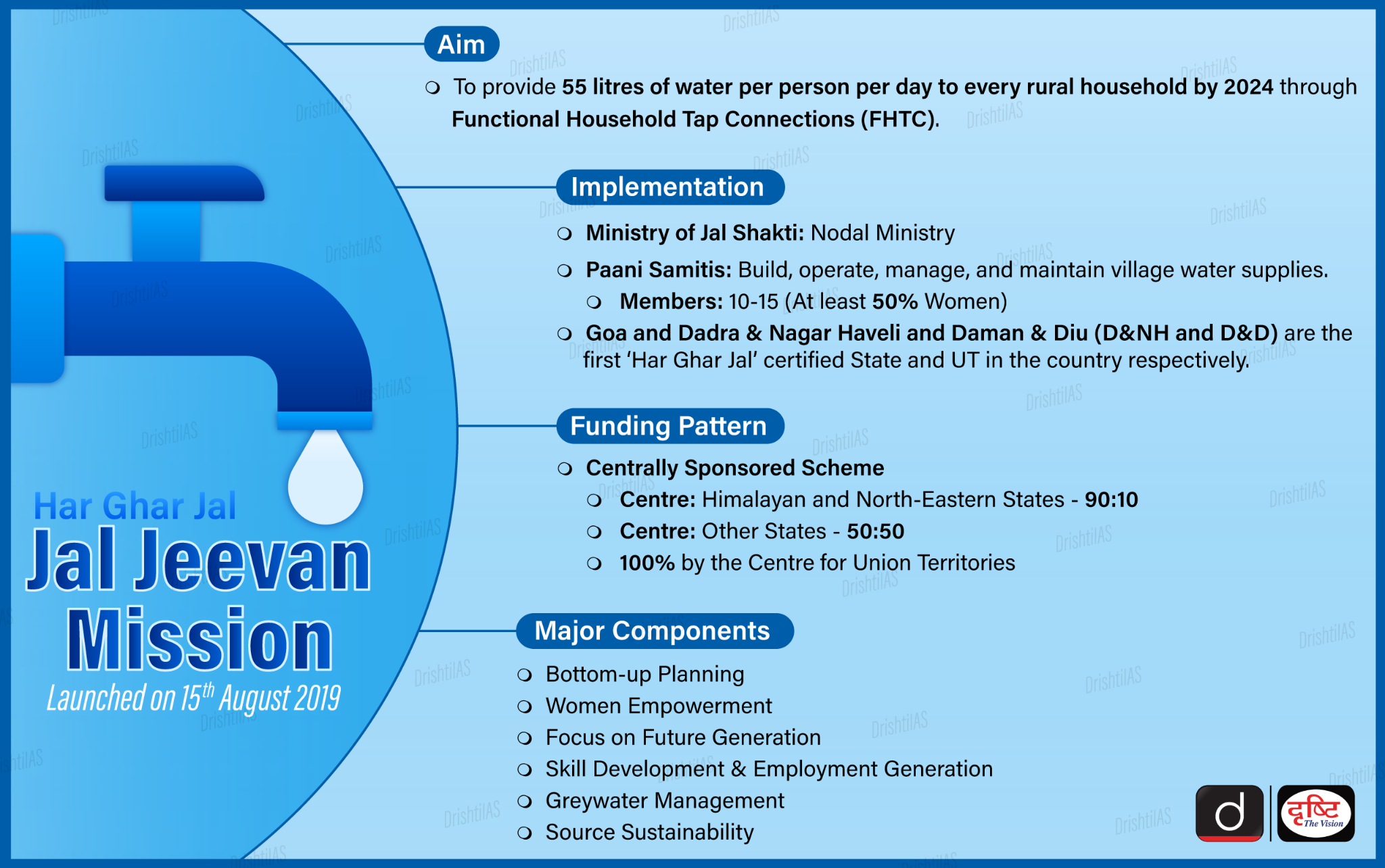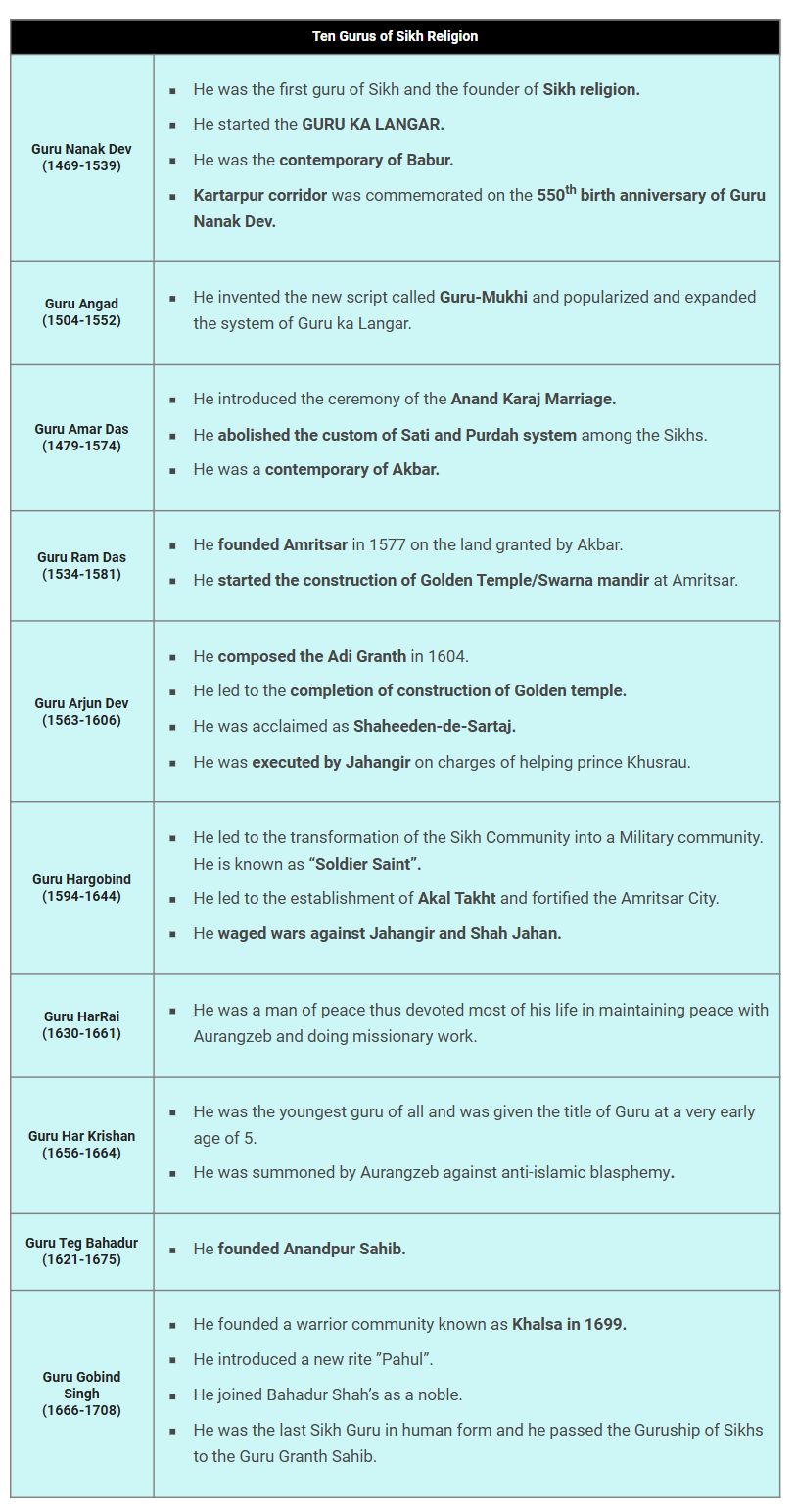Indian Economy
Decarbonising India’s Logistics Sector
For Prelims: Net zero emissions, Greenhouse gas (GHG), National Logistics Policy (NLP), PM Gati Shakti, Economic Survey 2023-24, Vision India@2047, World Bank’s Logistics Performance Index.
For Mains: State of Emission from Logistics Sector, Challenges in Decarbonising Logistics Sector, Way Forward for Sustainable Logistics Sector, Key Issues Associated with India's Logistical Sector.
Why in News?
India’s logistics sector, vital for economic growth and Vision India@2047, is among the most carbon-intensive. With a net-zero target by 2070, greening logistics is key to sustainable and inclusive development.
What is the Current Emissions Profile of India’s Logistics Sector?
- India: India’s logistics sector contributes about 13.5% of the country’s total greenhouse gas (GHG) emissions.
- Road transport dominates, managing nearly 90% of passenger and 70% of freight movement, and accounts for over 88% of sectoral emissions, trucks alone contribute around 38% of CO₂ emissions (IEA, 2023).
- Domestic aviation contributes about 4% to emissions, while coastal and inland shipping emit less than road freight. Warehousing also adds significantly due to high energy use.
- The government plans to triple inland waterway traffic and increase coastal shipping by 1.2 times by 2030, risking higher emissions if not managed sustainably.
- Global Scenario:
- Globally, the logistics sector accounts for around 7% of GHG emissions.
What are the Major Challenges in the Decarbonising Logistics Sector?
- Heavy Reliance on Road Transport: In India, roads dominate logistics due to inadequate rail and multimodal linkages. Roads carry 64.5% of freight and serve 90% of passenger traffic in India.
- This high dependence on diesel-fueled trucks makes rapid decarbonization technologically and economically challenging.
- Fragmented and Unorganized Sector: India’s logistics sector is largely unorganized, with over 85% of trucks owned by individuals or small operators, which hinders coordinated adoption of green technologies, emission tracking, and data sharing, making large-scale decarbonization efforts difficult.
- High Transition Costs & Limited Infrastructure: Transitioning to EVs or hydrogen vehicles requires significant upfront investment, with EVs costing 20-50% more than comparable Internal Combustion Engine (ICE) vehicles.
- Small fleet operators face limited access to green finance, and low-carbon fuels are more expensive than diesel, especially in emerging economies.
- Additionally, the scarcity of EV charging and hydrogen fueling stations, along with India's reliance on fossil fuels for over 70% of its electricity (CEA, 2023), hampers the effectiveness of electrification.
- Limited Adoption of Public Transport: The underdeveloped public transport infrastructure and infrequent services in many areas limit the potential for using public transport for freight, leading to continued reliance on carbon-intensive private vehicles leading to emissions and inefficiency in logistics operations.
| Click Here to Read More: Challenges in Transport Decarbonisation |
What are the Government Initiatives for the Decarbonising Logistics Sector?
- National Logistics Policy 2022: It aims to reduce logistics costs to 8%-9% of GDP by 2030 (from 13-14% of GDP) and be among the top 10 in the LPI (Logistics Performance Index) by 2030.
- PM Gati Shakti National Master Plan: It integrates infrastructure across highways, railways, and ports, promoting multimodal connectivity and reducing emissions.
- Dedicated Freight Corridors (DFCs) and Multimodal Logistics Parks (MMLPs) enhance rail and road connectivity, optimizing transport efficiency and reducing carbon footprints.
- FAME Scheme
- Unified Logistics Interface Platform (ULIP)
- LEADS (Logistics Ease Across Different States): Ranks states based on the efficiency of their logistics ecosystem.
- PM Electric Drive Revolution in Innovative Vehicle Enhancement (PM E-DRIVE) Scheme
What Measures Can be Taken to Reduce Emissions in India's Logistics Sector?
- Structural Shift from Road to Rail: India should increase the use of railways for freight transport, using its electrified rail network to cut emissions.
- Countries like the US and China have invested heavily in expanding their rail networks, which helps reduce freight transport emissions.
- Electrified rail is a nearly zero-carbon option, making it a sustainable choice for long-distance freight.
- Countries like the US and China have invested heavily in expanding their rail networks, which helps reduce freight transport emissions.
- Promoting EVs and Alternate Fuels: India should promote EV adoption in logistics through subsidies, charging infrastructure, and battery support, while also encouraging alternate fuels like CNG and biofuels. A strong policy framework and public-private investment are key to this transition.
- Boost Coastal Shipping and Inland Waterways: India should enhance coastal shipping and inland waterways for freight transport, as these modes offer low carbon emissions.
- Adopting cleaner technologies like LNG-powered vessels, solar-assisted boats, and biofuel-run barges will improve sustainability.
- Aligning with the International Maritime Organization's (IMO) target to cut global shipping emissions by 50% by 2050, these initiatives will support India's decarbonisation efforts.
- Towards Sustainable Aviation: Though air freight is a challenging sector to decarbonise due to its reliance on refined fuels, India can focus on enhancing aviation efficiency by investing in sustainable aviation fuels (SAFs) and promoting greener aircraft technologies.
- Additionally, integrating low-carbon solutions in other transport sectors can help offset emissions from air freight.
- Promoting Warehousing: India should promote green warehouses using renewable energy, energy-efficient materials, and smart automation systems to reduce emissions and enhance sustainability in the logistics sector.
- Regulating Emissions: India should introduce strict emission standards for the logistics sector, promote carbon credit or trading systems, and ensure compliance through regular audits and transparent reporting to drive sustainable practices.
India’s Logistical SectorClick Here to Read More: Key Issues in India's Logistical Sector, Enhancing the Efficiency of the Logistical Sector |
Conclusion
To achieve net-zero emissions by 2070, India must focus on making its logistics sector more sustainable. This can be done by boosting rail freight, making road transport electric, using clean fuels for ships, and improving energy efficiency in warehouses. With the right policies, technology, and private sector involvement, India can build a greener, more efficient logistics system for the future.
|
Drishti Mains Question: Discuss the challenges and opportunities in decarbonizing India's logistics sector. Highlight the key government initiatives. |
UPSC Civil Services Examination Previous Year Question (PYQ)
Q. The Gati-Shakti Yojana needs meticulous coordination between the government and the private sector to achieve the goal of connectivity. Discuss. (2022)


Governance
India's Leather Industry
For Prelims: National Green Tribunal, Indian Footwear and Leather Development Program, Production Linked Initiative Scheme, Goods and Services Tax, Viability Gap Funding
For Mains: Leather industry in India’s economy and employment, Sustainable industrialisation
Why in News?
The Centre has proposed a mega leather cluster in Ramaipur, Kanpur. This project seeks to rejuvenate the leather sector, which was once central to the city’s identity and economy, but now plagued by pollution curbs, declining business, and poor labour conditions.
What Led to the Decline of the Leather Industry in Kanpur?
- Legacy: Kanpur earned the title “Leather City of India” due to its flourishing British-era tanning industry, its proximity to the Ganga river, and abundant labor.
- The post-1857 boom created employment for over 1 lakh workers across 600 tanneries.
- Impact of Demonetisation and Pollution Control (2016–17): Demonetisation in 2016 hit Kanpur's leather industry hard, as cash shortages and limited digital financial inclusion halted payments and raw material purchases, drastically reducing production.
- Later, a 2017 directive from the UP Pollution Control Board (UPPCB) mandated a 50% infrastructure reduction, with a penalty of Rs 12,500 per day for non-compliance.
- Resulted in factories operating at half capacity or shutting down intermittently.
- Additionally, the National Green Tribunal (NGT) has raised concerns over tannery effluents polluting the Ganga and soil with heavy metals like chromium and mercury, which were also found at high levels in blood samples of residents in Kanpur and nearby areas.
- Rising Operational Costs: Tannery effluent treatment costs surged from Rs 2 to over Rs 100 per hide, shifting the pollution control burden onto tannery owners.
- Due to stricter compliance rules, the cost of wastewater treatment was shifted to businesses, significantly reducing profit margins.
- As a result, tanneries in Kanpur have reduced their operations from around 600 to just over 200, leading to widespread job cuts and a substantial loss of income for workers.
What is the Significance of India's Leather Industry?
- Leather Sub-sectors: India's Leather Industry comprises four verticals Tanning, Footwear, Leather Garments, and Accessories.
- States like Tamil Nadu, Uttar Pradesh, West Bengal, Maharashtra, and Punjab are leading producers.
- Global Leadership: India is the 2nd largest producer and consumer of leather footwear globally, after China.
- India is the 2nd largest exporter of leather garments after China, and the 4th largest exporter of leather goods in the world.
- It accounts for 13% of the world’s leather production, making it a major export contributor.
- India has 20% of the world’s cattle and buffalo population, and 11% of goat and sheep population, ensuring ample raw material supply.
- Employment: India's Leather Industry employs 4.42 million people, with 30% female workforce, particularly in rural regions.
- India’s Leather Export Profile: The garments sector accounted for 7.62% of the country’s total leather exports in FY25 (April-December).
- India exports leather to over 50 countries, with the US (21.82%), Germany (11.33%), and the UK (9.17%) as the top importers.
- India’s Initiatives: Council for Leather Exports (CLE), the apex export promotion council under the Ministry of Commerce, facilitates market access, buyer-seller meets, and provides a bridge between policy and industry.
- The Indian Footwear and Leather Development Program (IFLDP), with a budget of Rs 1,700 crore till 2026, aims to boost manufacturing competitiveness and employment generation in the leather sector.
- Proposed Production Linked Initiative (PLI) Scheme (Union Budget 2025–26) envisions a Rs 2,600 crore incentive scheme to increase turnover to Rs 4 lakh crore, generate 2.2 million jobs, and boost domestic value addition.
What are the Challenges Facing India's Leather Industry?
- Decline in Exports: Leather and leather goods exports dropped nearly 10% in FY24 due to weak demand from major markets like the US and Europe.
- Tamil Nadu, the largest leather exporter, saw an 18% decline, significantly affecting the national figures.
- The Russia-Ukraine war has disrupted the Eurozone economy, reducing international demand.
- Threat from Synthetic Leather Substitutes & Innovation Gap: The rise of eco-friendly alternatives like faux leather, cork leather, ocean leather, microfiber, and vegan leather is eroding leather’s niche market.
- These substitutes are cheaper, cruelty-free, and increasingly accepted in global markets, especially in environmentally conscious economies.
- While India's Leather Industry’s slow innovation and lack of R&D hinder its competitiveness.
- Environmental Regulations and Compliance Burden: Tanning is inherently polluting as it generates high chemical and organic waste, including hazardous materials like hexavalent chromium.
- Many tanneries lack capacity for effluent treatment and operate in unhygienic conditions, exposing workers to serious health risks.
- Workers are exposed to hazardous chemicals without adequate protection or awareness, leading to occupational health risks and poor labor welfare.
- Regulatory Challenges: Ban on slaughterhouses and restrictions on cattle trade have severely impacted raw material availability.
- The Goods and Services Tax (GST) regime increased costs by 6–7%, especially hurting Micro, Small and Medium Enterprises (MSMEs).
- Stricter norms by the NGT and UPPCB have led to closure of units, especially in hubs like Kanpur and Unnao.
- Labour Issues and Skill Gaps: A large section of the workforce is untrained and illiterate, leading to low productivity, Poor awareness of health and safety practices and Limited adaptation to new technologies
How Can India Revive its Leather Industry?
- Transform CETPs to CIRCLES: Transform Common Effluent Treatment Plants (CETPs) into CIRCLES (Clean Integrated Resource-Conserving Leather Ecosystems).
- Fund decentralised Zero Liquid Discharge (ZLD) micro-treatment plants through Viability Gap Funding (VGF).
- Mandate digital effluent metering and traceability, linked to a central Green Leather Compliance Dashboard (similar to the PARIVESH portal for environment clearances).
- Position India ‘China Plus One’: India can strategically position itself as a “China Plus One” hub in the global leather value chain amid rising US-China trade tensions.
- India can attract global buyers seeking reliable alternatives. Strengthening eco-compliance and design innovation will make India a preferred sourcing destination.
- Addressing the Innovation Gap: A National Leather Tech Hub can be established under the Council of Scientific and Industrial Research – Central Leather Research Institute (CSIR-CLRI) and the Atal Innovation Mission to foster innovation in the leather sector.
- This hub can collaborate with startups and MSMEs to co-develop biodegradable tanning agents, chrome-free alternatives, and smart wearable leather composites.
- Unlock Ethical Luxury Branding for Indian Leather: Introduce a “Bharat Leather Mark”, backed by sustainable sourcing and ethical labour audits.
- Launch a ‘100 Indian Leather Stories’ global branding campaign showcasing heritage artisanship from Kanpur, Ambur, Tamil Nadu and Kolkata.
- Encourage luxury collaboration with global fashion houses under Make in India.
- Formalise the Informal: Provide Digital Udyog Cards for every tannery worker to ensure access to skilling,health benefits, and accident insurance.
- Skill the Sector, Heal the Worker: A dedicated Worker Wellness Mission should provide mobile health labs in leather clusters.
- By integrating PM Vishwakarma Yojana artisans can be upskilled in modern, sustainable techniques. This will reduce attrition and boost productivity by 30–35%, securing a healthier and more resilient workforce.
Conclusion
India’s leather industry doesn’t need an incremental fix, it needs a strategic leap. If approached as an eco-creative and culturally rooted export engine, it can become the global benchmark for ethical leather craftsmanship. The Ramaipur cluster is not just a policy project, it could be the nucleus of a new leather revolution powered by tech, tradition, and trust.
|
Drishti Mains Question: India’s leather sector is facing the dual burden of global competition and domestic regulation. Critically analyse the causes of its decline and suggest a comprehensive revival strategy. |


Social Justice
India’s Fight Against Anemia
For Prelims: Anemia- Causes & Impact, Anaemia Mukt Bharat , 6X6X6 strategy, National Family Health Survey-5, Pradhan Mantri Surakshit Matritva Abhiyan.
For Mains: Women and Child welfare, Key Health initiatives.
Why in News?
The Ministry of Health and Family Welfare released a progress update on the Anemia Mukt Bharat (AMB) campaign, highlighting India’s sustained efforts to combat anemia, a major public health challenge.
What is Anemia Mukt Bharat (AMB) Campaign?
- About: It was launched in 2018 with the aim to reduce anemia through a 6x6x6 framework. It highlights major statistics from NFHS-5, including 67.1% of children and 59.1% of adolescent girls being anemic.
- The 6x6x6 framework targets 6 vulnerable groups with 6 key interventions through 6 institutional mechanisms to reduce anemia prevalence.
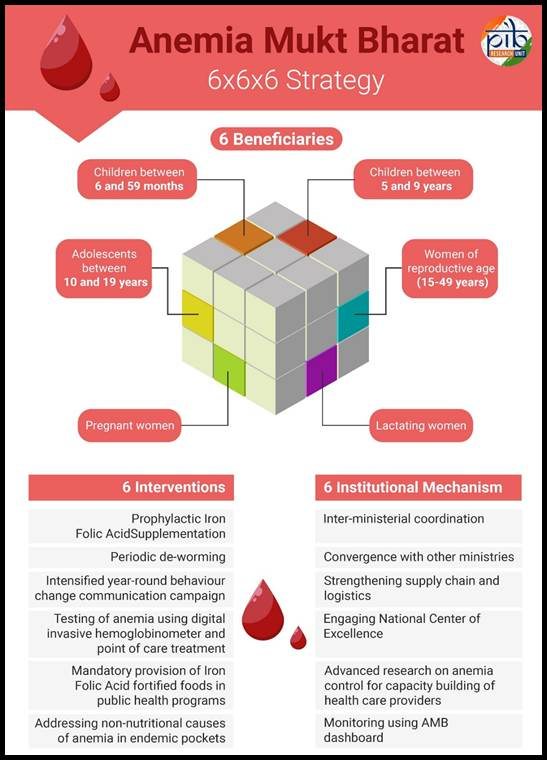
- 6 Key interventions:
- Iron and Folic Acid Supplementation: Age-appropriate Iron-Folic Acid (IFA) supplements are provided, with biweekly IFA syrup for children aged 6-59 months and weekly tablets for other groups.
- Deworming: Biannual deworming for children and adolescents (1-19 years) and antenatal deworming for pregnant women.
- Behavior Change Campaigns: Year-round campaigns focusing on key behaviors to combat anemia.
- Anemia Testing and Treatment: Use of digital methods for anemia screening, with special attention to pregnant women and adolescents.
- Fortification of Foods: Mandatory fortification of foods with Iron and Folic Acid in government programs.
- Awareness and Treatment for Non-Nutritional Causes: Special focus on malaria, hemoglobinopathies, and fluorosis in endemic areas.
- The 6x6x6 framework targets 6 vulnerable groups with 6 key interventions through 6 institutional mechanisms to reduce anemia prevalence.
- Progress Under AMB:
What is Anemia?
- About: Anemia is a condition primarily caused by iron deficiency, leading to low hemoglobin levels and reduced oxygen supply to organs, resulting in fatigue, weakness, and impaired physical and cognitive function.
- According to the WHO, women in the reproductive age group and having haemoglobin levels lower than 12 grams per decilitre (g / dL), as well as children under 5 with haemoglobin levels lower than 11.0 g / dL are considered anaemic.
- Vulnerability & Impact: Children under 5 (especially those under 2 years), adolescent girls, menstruating women, and pregnant and postpartum women are more vulnerable.
- Anemia causes Impair cognitive and motor development in infants and early children. In adults, it decreases work capacity. During pregnancy, it can lead to perinatal loss, prematurity, and low birth weight babies.
- Extent in India and Globally: Globally, 40% of children (6–59 months), 37% of pregnant women, and 30% of non-pregnant women (15–49 years) are affected by anemia.
- In 2019, anemia caused a loss of 50 million years of healthy life, primarily due to iron deficiency, thalassemia, sickle cell trait, and malaria.
- WHO Response: WHO has included anemia reduction as one of the 6 key targets in the Global Nutrition Targets and the UN 2030 Agenda for Sustainable Development.
- At the 2021 Nutrition for Growth Summit, WHO committed to developing a multisectoral framework for anemia prevention, diagnosis, and management, alongside UNICEF's Anaemia Action Alliance.
- WHO Global Nutrition Targets for 2025 (6 Key Goals):
- Reduce stunting in children under 5 by 40%
- Reduce anemia in women of reproductive age by 50%
- Reduce low birth weight by 30%
- Reduce childhood wasting to below 5%
- Increase exclusive breastfeeding in the first 6 months to 50%
- Prevent childhood obesity.
What are India’s Key Initiatives to Combat Anemia?
- Pradhan Mantri Surakshit Matritva Abhiyan (PMSMA)
- Health Management Information System (HMIS)
- Mission Utkarsh
- National Health Mission.
- Mother Child Tracking System (MCTS): This tracks and reports cases of anemia, especially among pregnant women.
- Blood Bank Operations: Strengthening blood banks in district hospitals to address severe anemia complications.
Conclusion:
India’s resolve to eliminate anemia reflects its broader commitment to inclusive and preventive public health. The Anemia Mukt Bharat strategy has made significant strides in reaching women, children, and adolescents through Iron-Folic Acid supplementation, deworming, etc. By focusing on the most vulnerable like girls, mothers, and young children, India is actively addressing the root causes of intergenerational malnutrition and promoting long-term human development.
|
Drishti Mains Question: Discuss the extent of the anemia burden in India and suggest effective strategies to address it, especially among vulnerable populations. |
UPSC Civil Services Examination, Previous Year Questions (PYQs)
Prelims
Q. Which one of the following statements best describes the role of B cells and T cells in the human body? (2022)
(a) They protect the body from environmental allergens.
(b) They alleviate the body’s pain and inflammation.
(c) They act as immunosuppressants in the body.
(d) They protect the body from the diseases caused by pathogens.
Ans: D
Q. Consider the following statements in the context of interventions being undertaken under Anaemia Mukt Bharat: (2023)
- It provides prophylactic calcium supplementation for pre-school children, adolescents and pregnant women.
- It runs a campaign for delayed cord clamping at the time of childbirth.
- It provides for periodic deworming to children and adolescents.
- It addresses non-nutritional causes of anaemia in endemic pockets with special focus on malaria, hemoglobinopathies and fluorosis.
How many of the statements given above are correct?
a) Only one
b) Only two
c) Only three
d) All four Interventions of Anaemia Mukt Bharat:
Ans: (c)
Mains
Q. Stem cell therapy is gaining popularity in India to treat a wide variety of medical conditions including Leukaemia, Thalassemia, damaged cornea and several burns. Describe briefly what stem cell therapy is and what advantages it has over other treatments? (2017)


Important Facts For Prelims
BharatNet Project
Why in News?
The BharatNet project is making significant progress in connecting rural India with high-speed internet, fostering inclusive growth and bridging the urban-rural divide.
What is BharatNet?
- About: The National Optical Fibre Network (NOFN) was launched in 2011 and later renamed the BharatNet Project in 2015 under the Ministry of Communications.
- It aimed at providing high-speed broadband connectivity to every Gram Panchayat (GP) across the country.
- It is one of the largest rural telecom projects in the world, designed to offer affordable broadband access and enable the delivery of e-health, e-education, and e-governance services in rural India.
- The project initially aimed to connect approximately 2.5 lakh GPs across the country.
- Phases of Implementation:
- Phase I: Connected 1 lakh GPs using optical fiber (OF) cables and existing infrastructure, completed in 2017.
- Phase II (ongoing): Expands coverage to 1.5 lakh GPs using optical fiber, radio, and satellite technologies, with collaboration from state governments and private entities.
- Phase III (ongoing): Focuses on integrating 5G technologies, increasing bandwidth, and enhancing last-mile connectivity.
- The Amended BharatNet Program (ABP), approved in 2023, is part of this phase.
- Amended BharatNet Program: It aims to provide optical fiber connectivity to 2.64 lakh GPs in ring topology (a network design where connected devices form a circular data channel) and OF connectivity to non-GP villages on demand.
- It includes features such as an Internet Protocol Multi-Protocol Label Switching network (a method for efficiently routing data across networks) with routers at Blocks and GPs and Remote Fibre Monitoring System (a system for monitoring the status of OF connections remotely).
- Funding and Execution: BharatNet is primarily funded through the Digital Bharat Nidhi (DBN), a fund that replaced the Universal Service Obligation Fund.
- The project is executed by the Special Purpose Vehicle (SPV), Bharat Broadband Network Limited (BBNL), incorporated under the Indian Companies Act 1956.
- Under the ABP, Bharat Sanchar Nigam Limited (BSNL) serves as the Project Management Agency for the operation and maintenance of the network.
- Current Status: As of 2025, approximately 2.18 lakh GPs have been made service-ready under the BharatNet project.
- The total Optical Fiber Cable (OFC) length has surpassed 42 lakh route kilometers.
- Additionally, more than 12 lakh Fibre-To-The-Home (FTTH) connections have been commissioned, and over 1 lakh Wi-Fi hotspots have been installed.
- The total Optical Fiber Cable (OFC) length has surpassed 42 lakh route kilometers.
Other Initiatives Supporting Digital Empowerment in Rural India
- Pradhan Mantri Gramin Digital Saksharta Abhiyan (PMGDISHA): Aims to ensure digital literacy in rural households, trained over 6.39 crore individuals by March 2024.
- National Broadband Mission (NBM): Launched to accelerate digital infrastructure, it includes NBM 2.0 (launched in January 2025).
- Key initiatives under NBM include the Centralized Right of Way (RoW) Portal GatiShakti Sanchar.
- CSC e-Governance Services India Limited (CSC SPV): A SPV, set up by the Ministry of Electronics & IT under the Companies Act, 1956, provides a collaborative framework for service delivery through CSCs.
- As of September 2024, it has installed 1.04 lakh Wi-Fi access points and 11.42 lakh FTTH connections in GPs, and also piloted overhead optical fiber deployment under BharatNet.
- Mobile Connectivity: By December 2024, around 6.25 lakh villages were mobile-connected, with 6.18 lakh having 4G coverage. This complements BharatNet in bridging the digital divide.
- India has achieved the world’s fastest 5G rollout, with over 4 lakh 5G Base Transceiver Stations (BTSs) deployed across 779 districts.
UPSC Civil Services Examination Previous Year Question (PYQ)
Prelims
Q. Consider the following: (2022)
- Aarogya Setu
- CoWIN
- DigiLocker
- DIKSHA
Which of the above are built on top of open-source digital platforms?
(a) 1 and 2 only
(b) 2, 3 and 4 only
(c) 1, 3 and 4 only
(d) 1, 2, 3 and 4
Ans: (d)
Mains
Q. “The emergence of the Fourth Industrial Revolution (Digital Revolution) has initiated e-Governance as an integral part of government”. Discuss. (2020)


Rapid Fire
Gold’s Rising Share in India’s Forex Reserve
As per the World Gold Council (WGC), India's gold share in foreign exchange reserves has nearly doubled from 6.7% in 2019 to 12% by February 2025.
- India’s forex reserves rose to USD 677.84 billion in April 2025, led by an increase of USD 892 million in FCA and a USD 638 million rise in gold reserves, while SDRs fell by USD 6 million.
Foreign Exchange Reserves (Forex Reserves):
- About: Forex are reserve assets held by a central bank in foreign currencies. It may include foreign currencies, bonds, treasury bills and other government securities, typically denominated in US dollars.
- They are an important component of the Balance of Payment (BoP)
- The RBI is the custodian of India's foreign exchange reserves, deriving its authority from the provisions of the RBI Act, 1934.
- Purpose: It helps meet external payment needs and stabilize the national currency.
- They also serve as a buffer during global financial shocks and ensure confidence in monetary policies.
- Components of India’s Forex Reserves:
- Foreign Currency Assets (FCA) (largest contributor)
- Gold reserves (second largest contributor)
- Special Drawing Rights
- It is not a currency but its value is determined by a basket of 5 major currencies: the US dollar, euro, Chinese renminbi, Japanese yen, and British pound sterling.
- Reserve Tranche Position (RTP) with the IMF
- RTP is a country's quota-based access to IMF resources, available for borrowing without strict conditions, used for BoPs or financial stability.
| Read More: Rise in Forex Reserves |


Rapid Fire
Jal Jeevan Mission Faces Funding Cuts
The Jal Shakti Ministry sought an additional Rs 2.79 lakh crore to complete the Jal Jeevan Mission (JJM).
- However, the Expenditure Finance Committee(EFC) (under the Ministry of Finance) approved only Rs 1.51 lakh crore, potentially shifting over Rs 1.25 lakh crore burden to states.
- Jal Jeevan Mission: Launched in 2019, it aims to provide tap water to all 16 crore rural households by December 2024, currently, 75% coverage achieved, with nearly 4 crore households still pending.
- The mission is now proposed to be extended till December 2028 to achieve universal coverage.
- The fund sharing pattern between Centre and State is 90:10 for Himalayan (Uttarakhand, Himachal Pradesh) and North-Eastern States, 100:0 for UTs and 50:50 for the rest of the States.
- Funding Issues: The Jal Shakti Ministry demanded Rs 2.79 lakh crore as the Central share for 2024–2028 to complete the remaining tap water installations, citing inflated costs due to rising input prices.
- However, the EFC recommended only Rs 1.51 lakh crore, citing concerns over cost escalation, potential overestimation by states, and fiscal prudence.
- As a result, the revised total outlay for the mission was reduced from Rs 9.10 lakh crore to Rs 8.68 lakh crore (2019-2028).
- Implications: States may have to cover the funding shortfall, especially in Uttar Pradesh, Rajasthan, and Madhya Pradesh.
| Read more: Jal Jeevan Mission |


Rapid Fire
KVIC’s Record Growth Fuels Rural Empowerment
The Khadi and Village Industries Commission (KVIC) has recorded an unprecedented turnover of over Rs 1.7 lakh crore for FY 2024-25.
- Achievements of KVIC: Over the past 11 years (2013–2025), KVIC production rose by 347% and sales by 447%. Employment grew by 49.23%, providing jobs to 1.94 crore individuals.
- Khadi clothes production increased by 366%, and sales surged by 561%. Khadi artisans' wages rose by 275% over 11 years, with a 100% increase in the last 3 years.
- Women make up 57.45% of KVIC trainees, and 80% of Khadi artisans are women.
- KVIC: It is a statutory body established under the KVIC Act, 1956 and functions under the Ministry of Micro, Small & Medium Enterprises.
- It is responsible for the planning, promotion, and development of Khadi and village industries in rural areas.
- KVIC provides raw materials, supports marketing, promotes research and innovation, ensures product authenticity, and offers financial and technical support. State-level Khadi Boards implement KVIC schemes locally.
- Key Schemes Related to KVIC: Pradhan Mantri Employment Generation Program (PMEGP) led to the establishment of over 10 lakh new micro enterprises, benefiting 90 lakh individuals.
- Under the Gramodyog Vikas Yojana, over 2.87 lakh machines and toolkits were distributed to boost rural entrepreneurship.
| Read more:Gramodyog Vikas Yojana and Village Industries |


Rapid Fire
Guru Tegh Bahadur Prakash Purab
Prime Minister paid tributes to Guru Tegh Bahadur on his birth anniversary (Prakash Purab) on 18th April, 2025.
Prakash Purab
- In Sikhism, Prakash (light) Purab (day or occasion) refers to the birth anniversaries of Sikh Gurus or significant religious events, symbolising the illumination of spiritual knowledge.
Guru Tegh Bahadur
- He was the 9th sikh guru, revered for his teachings, bravery, and martyrdom.
- Born on 21st April 1621 in Amritsar to Guru Hargobind (6th sikh guru) and Mata Nanki, Guru Tegh Bahadur was originally named Tyag Mal for his ascetic nature.
- Trained by Bhai Gurdas in scriptures and by Baba Budha in martial arts, he distinguished himself in battle at the age of 13.
- He contributed 116 hymns to the Guru Granth Sahib, travelled widely to spread Sikh teachings, and founded Chak-Nanki (now part of Anandpur Sahib).
- In 1675, he was executed in Delhi on the orders of Mughal Emperor Aurangzeb for defending religious freedom against forced conversions, earning the title “Hind di Chadar” (Protector of Hind).
| Read More: Akal Takht |




